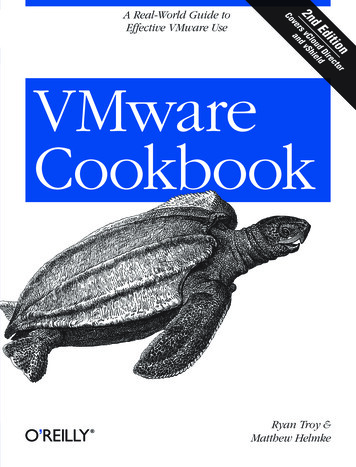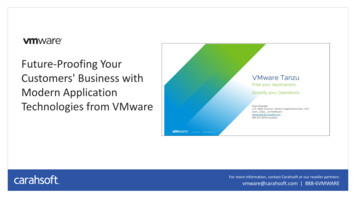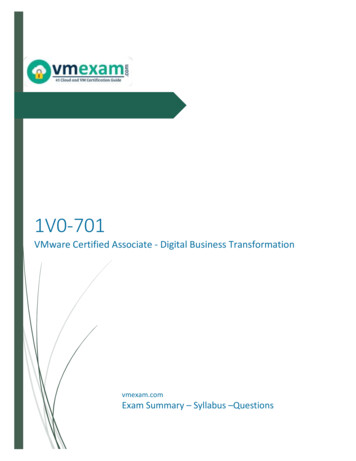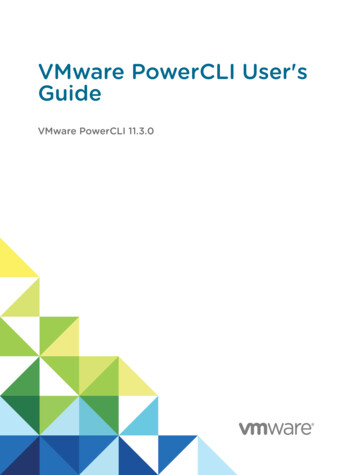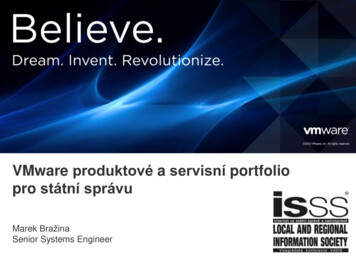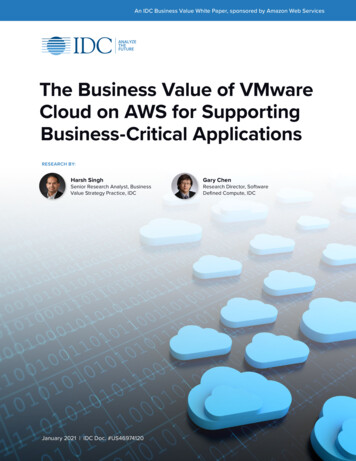
Transcription
An IDC Business Value White Paper, sponsored by Amazon Web ServicesThe Business Value of VMwareCloud on AWS for SupportingBusiness-Critical ApplicationsRESEARCH BY:Harsh SinghSenior Research Analyst, BusinessValue Strategy Practice, IDCJanuary 2021 IDC Doc. #US46974120Gary ChenResearch Director, SoftwareDefined Compute, IDC
The Business Value of VMware Cloud on AWS for Supporting Business-Critical ApplicationsNavigating this White PaperClick on titles or page numbers to navigate to each section.Business Value Highlights . . . . . . . . . . . . . . . . . . . . . . . . . . . . . . . . . . . . . . . . . . . . . . . . . . . . . . . . . . . . . . . . . . . . . . . 3Executive Summary. . . . . . . . . . . . . . . . . . . . . . . . . . . . . . . . . . . . . . . . . . . . . . . . . . . . . . . . . . . . . . . . . . . . . . . . . . . . . . . 3Situation Overview . . . . . . . . . . . . . . . . . . . . . . . . . . . . . . . . . . . . . . . . . . . . . . . . . . . . . . . . . . . . . . . . . . . . . . . . . . . . . . . 4Overview of VMware Cloud on AWS . . . . . . . . . . . . . . . . . . . . . . . . . . . . . . . . . . . . . . . . . . . . . . . . . . . . . . . . . . . 5The Business Value of VMware Cloud on AWS . . . . . . . . . . . . . . . . . . . . . . . . . . . . . . . . . . . . . . . . . . . . . . . 7Study Demographics. . . . . . . . . . . . . . . . . . . . . . . . . . . . . . . . . . . . . . . . . . . . . . . . . . . . . . . . . . . . . . . . . . . . . . . . . . 7Choice and Use of VMware Cloud on AWS . . . . . . . . . . . . . . . . . . . . . . . . . . . . . . . . . . . . . . . . . . . . . . . . 8Business Value and Quantified Benefits. . . . . . . . . . . . . . . . . . . . . . . . . . . . . . . . . . . . . . . . . . . . . . . . . . . . . . . 9Improved IT Operations, Data Migration, and Cost of Operation . . . . . . . . . . . . . . . . . . . . . . . . . . 11The Business Impact of VMware on AWS . . . . . . . . . . . . . . . . . . . . . . . . . . . . . . . . . . . . . . . . . . . . . . . . . . . . 16ROI Summary. . . . . . . . . . . . . . . . . . . . . . . . . . . . . . . . . . . . . . . . . . . . . . . . . . . . . . . . . . . . . . . . . . . . . . . . . . . . . . . . . . . . . 21Challenges/Opportunities . . . . . . . . . . . . . . . . . . . . . . . . . . . . . . . . . . . . . . . . . . . . . . . . . . . . . . . . . . . . . . . . . . . . . . 22Conclusion . . . . . . . . . . . . . . . . . . . . . . . . . . . . . . . . . . . . . . . . . . . . . . . . . . . . . . . . . . . . . . . . . . . . . . . . . . . . . . . . . . . . . . . 22Appendix: Methodology. . . . . . . . . . . . . . . . . . . . . . . . . . . . . . . . . . . . . . . . . . . . . . . . . . . . . . . . . . . . . . . . . . . . . . . . 23About the Analysts . . . . . . . . . . . . . . . . . . . . . . . . . . . . . . . . . . . . . . . . . . . . . . . . . . . . . . . . . . . . . . . . . . . . . . . . . . . . . . 25Message from the Sponsor. . . . . . . . . . . . . . . . . . . . . . . . . . . . . . . . . . . . . . . . . . . . . . . . . . . . . . . . . . . . . . . . . . . . 26IDC Business Value White Paper, sponsored by Amazon Web ServicesDoc. #US469741202
The Business Value of VMware Cloud on AWS for Supporting Business-Critical ApplicationsBUSINESS VALUE HIGHLIGHTSClick on highlights below to navigate to related content within this white paper.479%37% increase76% reduction 9.6M13% more efficient40% reduction40% more efficient46% faster5-year ROIin application performancetotal new revenuegained per yearcompliance teams18% more productivedeveloper teamsIT infrastructuremanagementin unplanned downtimein IT infrastructure costscloud migrationsExecutive SummaryOver the past decade, public cloud has been rising to become the major forcethat is reshaping the IT industry. The transition to cloud is long and multifaceted,encompassing different types of workloads and cloud models. Customers are bothbuilding new cloud-native applications as well as migrating existing applications(that cannot be practically rewritten or refactored) to the cloud. While public cloudis a huge shift for industry, on-premises is not going away completely. The needto seamlessly integrate the public cloud and on-premises environments into a hybridcloud is crucial to avoiding the creation of additional siloes and increasing flexibilityand agility. The reality is that cloud, in all its forms, is inevitable for organizations,because the competitive nature of business will drive them to innovate, cut costs,and develop digital assets more quickly.Amazon Web Services (AWS) is VMware’s preferred public cloud partner for allvSphere-based workloads. VMware Cloud on AWS brings VMware’s SoftwareDefined Data Center software to the AWS Cloud and enables customers to runproduction applications across VMware vSphere-based private, public, and hybridcloud environments, with optimized access to AWS services. The deploymentof this solution paves the way for organizations to modernize their business-criticalapplications with jointly engineered and supported services from AWS and VMware.IDC interviewed organizations across multiple industries about the impact ofrunning their business-critical applications on VMware Cloud on AWS. Studyparticipants identified key benefits in adopting the service, including the ability toefficiently migrate workloads to the public cloud while optimizing performance, agility,and cost. This also allowed them to leverage their existing VMware technologies,knowledge, governance, and best practices. Based on interviews with 17 VMwareCloud on AWS customers, IDC puts the average annual benefit they will achieveat 5.31 million per organization (or 958,700 per 100 virtual machines [VMs]).IDC Business Value White Paper, sponsored by Amazon Web ServicesDoc. #US46974120The reality is thatcloud, in all itsforms, is inevitablefor organizations,because thecompetitive natureof business willdrive them toinnovate, cutcosts, and developdigital assets morequickly.Table of Contents3
The Business Value of VMware Cloud on AWS for Supporting Business-Critical ApplicationsThe average annual benefit is achieved through:Fostering more efficient IT infrastructure management teams as well as databaseadministrators (DBAs) and development and compliance teamsProviding robust application and business support with improved agility, scalability,and performance to help organizations address business opportunities andincrease revenueReducing the frequency and duration of unplanned outages, thereby minimizingcosts related to lost productivity and revenueEnabling more efficient use of resources to reduce costs for running their ITinfrastructure to support workloads and applicationsSituation OverviewFor the past decade, public cloud has been changing organizations’ IT strategies as theygrapple with digital transformation. Digital transformation has pushed organizations ofall types to produce more innovative applications, develop and deploy them faster, andoperate them at a larger scale. The instant and on-demand nature of cloud serviceswas immediately alluring to customers looking to experiment and deploy more quicklyand led to the fast rise of public cloud. Organizations also began to rethink what theywanted to control and manage. With cloud, organizations can offload infrastructuremanagement and devote more resources to areas such as applications and their own IP.Public cloud service models and architectures have also influenced on-premisesenterprise datacenters, with private clouds in demand and growing at the expense oftraditional IT. This has led to the concept of hybrid clouds, which is the integration ofpublic and private clouds. Hybrid cloud is not a single technology but rather the useof multiple technologies and strategies at various levels of the stack to achieve moreconsistency and manageability. The level of integration can vary greatly, but the tighterthe integration, the greater the level of seamlessness. A fully consistent environment,down to the lowest levels of the software stack, can simplify management, provideoperational consistency, and enable easy portability between environments to helpcreate a more unified environment between on-premises and public cloud.The instant andon-demand natureof cloud serviceswas immediatelyalluring to customerslooking to experimentand deploy morequickly and ledto the fast rise ofpublic cloud.One of the challenges for customers moving to the public cloud is the migration ofexisting workloads. The reality for many is that they have a large portfolio of existingapplications that cannot be decommissioned overnight and replaced with a cloud-nativeversion. These applications were not designed for cloud and have a different set ofinfrastructure assumptions and dependencies. However, companies are looking for acloud strategy to address these applications and modernize them.The main challenge is that while virtualization is ubiquitous today, the virtualization withinenterprise datacenters is often different than what is in the public cloud. While thereare tools that can convert one VM format to another, the hurdles go far beyond VMformats. For example, different VM platforms also mean different attached networkingand storage subsystems. Thus, performance optimizations, ISV certifications, automation,IDC Business Value White Paper, sponsored by Amazon Web ServicesDoc. #US46974120Table of Contents4
The Business Value of VMware Cloud on AWS for Supporting Business-Critical Applicationsand toolsets usually change. This extends to other processes that can be infrastructurespecific, such as high availability, backup, and disaster recovery. Doing any kind ofplatform migration is extremely challenging as it means refactoring and learning a newset of skills, tools, and processes to manage applications.In order to avoid refactoring and achieve a seamless migration, one strategy is to havea similar software stack on-premises and in the public cloud, from the hypervisor onup the stack. This consistency is particularly beneficial for legacy workloads that aretightly coupled to the infrastructure environments.A highly integrated hybrid cloud allows for:Seamless portability: Workloads can be moved in either direction. A fully consistentenvironment means that when an application is moved, most of its optimizations,integrations, and attached management process can also come with it.Unified networking: Combining both environments into a single logical networkavoids DNS and IP address-change problems as workloads move betweenenvironments.Consistent operations: Using a single platform allows users to keep the sameoperational processes and manage the entire hybrid environment with a single setof tools within a single unified team.Modernization: Integrated access to cloud-native services can enable modernizationof existing applications and build new applications.Solving these integration challenges means that the public cloud can become aseamless extension of enterprise datacenters to address legacy applications while alsosupporting next-generation cloud-native applications. It also allows organizations tobe flexible with the mixture of on-premises and cloud, with the ability to change the ratioas needed with bidirectional portability.The road to cloud requires the adoption of many different types of cloud technologies.The fully consistent hybrid cloud is an essential tool for addressing the migrationand management of existing datacenter workloads in the cloud.Overview of VMware Cloud on AWSVMware Cloud on AWS is the preferred service for AWS for all vSphere workloads.It combines the VMware software stack that is a mainstay in enterprise datacenters withthe scale and global reach of AWS regions. VMware Cloud on AWS is jointly engineeredby AWS and VMware and is fully operated by VMware on the AWS cloud.VMware Cloud on AWS enables several key use cases:Datacenter extensionDatacenter exit or cloud migrationApplication modernizationDisaster recoveryIDC Business Value White Paper, sponsored by Amazon Web ServicesDoc. #US46974120Table of Contents5
The Business Value of VMware Cloud on AWS for Supporting Business-Critical ApplicationsBy using the same VMware software that customers have in their own datacenters,VMware Cloud on AWS becomes a seamless extension of on-premises datacenters,with unified management of on-premises and cloud resources through the familiarvCenter and vRealize interfaces. Using familiar VMware tools means IT staff don’thave to learn new skills and interfaces when expanding to the public cloud.VMware’s Software Defined Datacenter enables a consistent hybrid cloudwith key subsystems such as:VMware Cloud onAWS addressesseveral concerns andchallenges whenmigrating datacenterapplications tothe cloud.Live migration of workloads with the VMware HCX service or Cloud Motion withvSphere ReplicationVMware’s software-defined networking (VMware NSX) which creates a unifiednetwork for easy workload migration without dealing with IP address changes.Customers that have NSX on-premises can maintain consistency in establishednetwork and security policies in VMware Cloud on AWS.VMware vSAN running on local storage which provides vSphere-native, highperformance, and highly secure storage in VMware Cloud on AWS.VMware Cloud on AWS addresses several concerns and challenges whenmigrating datacenter applications to the cloud:VMware clusters in VMware Cloud on AWS are fully dedicated at the physical serverlevel, which means a higher level of security and performance since the server isnot shared with other tenants.Most applications and tools that work on VMware will work on VMware Cloud onAWS. VMware Cloud on AWS has its own certification process for applications andtools, and these are listed on the VMware marketplace. The high level of compatibilitywill ease the migration of many existing applications and their dependencies.VMware Cloud on AWS also addresses more than just traditional datacenter serverworkloads. VMware Horizon on VMware Cloud on AWS offers the ability to runcloud-hosted virtual desktops, which can be added and extended by leveraging cloudscale and agility. The consumption-based nature of cloud infrastructure can also helpoptimize virtual desktop infrastructure (VDI) costs, in paying only for what is used.While VMware Cloud on AWS uses the same VMware components that VMware usershave on-premises, it is also built as a cloud-first solution.VMware Cloud on AWS leverages a combination of VMware’s SoftwareDefined Data Center and AWS’s cloud infrastructure and services:On-demand capacity and flexible consumption models: Clusters can be configuredand provisioned in just a couple of hours, and new hosts can be added in minutes.Self-service to improve developer productivityAPI-enabled to allow infrastructure as code and automationVMware Tanzu Kubernetes Grid adds the capability to run Kubernetes-orchestratedcontainers on VMware Cloud on AWS.IDC Business Value White Paper, sponsored by Amazon Web ServicesDoc. #US46974120Table of Contents6
The Business Value of VMware Cloud on AWS for Supporting Business-Critical ApplicationsThe full range of AWS native services are available to VMware Cloud on AWS forapplication modernization. Because they are located in the same cloud, userswill get high-throughput, low-latency access to AWS services.The global reach and scale-out capacity of AWS can be leveraged by VMware usersand workloads.The Business Valueof VMware Cloud on AWSStudy DemographicsIDC conducted research that explored the value and benefits for organizations inbusiness-critical workloads and applications on VMware Cloud on AWS. The projectincluded 17 interviews with organizations that had experience with and knowledgeabout the benefits and costs of using this platform. The interviews covered a varietyof quantitative and qualitative questions about the impact on their IT operations,costs, and business results.Table 1 presents the study demographics and profiles. The organizations interviewedhad a base of 36,979 employees, which would indicate several large companies, butthe median was 7,200, meaning IDC interviewed several smaller firms (the smallestbeing a 550-person organization). In terms of geographical distribution, 14 companieswere based in the United States and three in Australia. (Note: All numbers cited inthis paragraph represent averages.)TABLE 1Firmographics of Interviewed OrganizationsAverageMedianRangeNumber of employees36,9797,200550 to 257,000Number of IT staff2,63728012 to 22,500Number of IT users35,6365,300550 to 244,150Number of business applications3,0091885 to 25,000Revenue per year 11.6B 1.70B 65M to 115.6BCountriesUnited States (14), Australia (3)IndustriesHealthcare (4), financial services (3), retail (3), government (2), professional services (2), insurance, manufacturing, telecommunicationsn 17, Source: IDC In-depth Interviews, December 2020IDC Business Value White Paper, sponsored by Amazon Web ServicesDoc. #US46974120Table of Contents7
The Business Value of VMware Cloud on AWS for Supporting Business-Critical ApplicationsChoice and Use of VMware Cloud on AWSInterviewed organizations discussed the rationale behind their decisions to adoptVMware Cloud on AWS. Organizations cited their ability to leverage VMware-basedsolutions as well as the quality and rich functionality of VMware Cloud on AWS asa public cloud solution, which allowed them to leverage the scalability and flexibilityof the public cloud to scale globally. Study participants also appreciated theease of multi-directional workload migration between their on-premises VMwareenvironments and VMware Cloud on AWS. The ability to use the same VMwaretechnologies that IT team members were already familiar with was an importantconsideration for many companies, as it minimized the time and expense associatedwith training. Proactive customer support and reduced costs were also cited asimportant factors in their decisions.The ability to usethe same VMwaretechnologies that ITteam members werealready familiar withwas an importantconsideration formany companies,as it minimized thetime and expenseassociated withtraining.Study participants explained these considerations:The ability to scale globally:“We needed to scale our application across the globe in different regions, and byusing AWS we can remove the infrastructure management that we were doingon our part and have AWS and VMware handle that.”Easier migration:“We thought the idea would be to work out how to migrate everything ourselves,and maybe refactor applications and things like that. But we couldn’t guesstimatehow long it’s going to take, and how much that will cost. So then we thought theeasiest thing is just lift what we have on-premises and put it in AWS. VMware Cloudon AWS allowed us to just do that. We set up a similar VMware environment andall of our servers exactly as they were. Everything kept running, and that gave usthe confidence in the environment.”Proactive customer support:“The main reason we chose AWS was because of the tools it integrates with in termsof reporting and performance. It gives proactive visibility into some of these things.Another factor was support. Other providers will say, ’Well, this is not our issue,you need to go and deal with your third party.’ AWS actually goes above andbeyond to say, ’Okay, what are you looking into? Let me help you out with it.’ And:’Here’s what I would recommend.’ Even if it’s not their issue, they will help figureout some of the challenges and make sure we do what’s necessary. They providea tremendous service.”Reduced costs and experience running VMware applications:“The reason for choosing AWS over other providers was cost. That’s always importantto us. Having experience with VMware applications was also important in selectingVMware Cloud on AWS, since we used their virtual software on our in-house servers.”Easier management and reduced third-party costs:“We were looking at more business agility and trying to get away from having toconstantly hire contractors. The executives got frustrated because they were seeingvery slow movement, adoption, and speed to delivery. Everything here is nowowned, managed, and supported officially by VMware, and it gives our executivespeace of mind.”IDC Business Value White Paper, sponsored by Amazon Web ServicesDoc. #US46974120Table of Contents8
The Business Value of VMware Cloud on AWS for Supporting Business-Critical ApplicationsTable 2 provides a snapshot of VMware Cloud on AWS use by interviewed organizations. Onaverage, they reported running 95 business applications supported by a total of 64 databasesand 180 TBs of system data capacity. 42% of all end users were engaged with applicationssupported by VMware Cloud on AWS.TABLE 2VMware Cloud on AWS EnvironmentsAverageMedianNumber of virtual instances/VMs55455Number of business applications9518Number of databases6414Amount of storage, TBs18050Number of countries in which customers haveoperations53Number of sites/branches in which customers areaccessing VMware Cloud on AWS479Percentage of internal users using VMware Cloudon AWS applications42%26%n 17, Source: IDC In-depth Interviews, December 2020Business Valueand Quantified BenefitsInterviewed organizations attributed significant value to running their business applications onVMware Cloud on AWS. They cited the benefits of more efficient IT infrastructure managementteams along with database administrators (DBA) and development and compliance teams.They confirmed that the service cost-effectively provided robust application and businesssupport with agility, scalability, and performance, helping their organizations address businessopportunities and increase revenue. It also helped to reduce the frequency and duration ofunplanned outages, thereby minimizing costs related to lost productivity and revenue.Interviewed VMware customers spoke to these and other advantages ofVMware Cloud on AWS:Easier management:“The IT benefit is that you don’t need your people to learn another technology. All theknowledge to run and maintain the systems your technology people already have becausethey’re familiar with VMware.”IDC Business Value White Paper, sponsored by Amazon Web ServicesDoc. #US46974120Table of Contents9
The Business Value of VMware Cloud on AWS for Supporting Business-Critical ApplicationsEasier to set up in a new region:“We’re still rolling out new infrastructure and building up with much less hassle acrossmultiple locations. Also, procurement is quite easy because we don’t have to waitfor hardware, a process that normally takes a long time.”Quicker and more accurate migrations:“The ability to migrate to the cloud and the speed of migration to the cloud isincredible.”Better adoption speed and scalability:“The biggest benefits are speed of adoption and ability to do scaling up and downfairly easily. High-end vendor support is important to us, being able to provisioninstances dynamically, and automation behind those instances. Those would be thebig drivers.”Based on interviewswith VMware Cloudon AWS customers,IDC calculates thatthey will achievevalue worth anannual average of 5.31 million perorganization,or 958.7K per100 VM.Improved scalability helping business productivity:“The benefits are an increase in productivity, efficiency, stability, and scalabilitybecause we’re able to scale in a matter of minutes, compared to a matter of hours.”Based on interviews with VMware Cloud on AWS customers, IDC calculatesthat they will achieve value worth an annual average of 5.31 millionper organization, or 958.7K per 100 VMs utilized in the following areas(Figure 1, next page):IT staff productivity benefits:Study participants derive benefits from the ease of use and robust functionality ofVMware Cloud on AWS to minimize day-to-day work for IT teams. As a result,IDC projects that they will realize staff time savings and productivity gains worthan average of 2.58M per organization ( 466,500 per 100 VMs).Business productivity benefits:Study participants support their business activities with greater flexibility andimproved IT infrastructure performance, helping to satisfy existing customers andgarner new business opportunities. IDC puts the value of higher revenue at anannual average of 1.41M per organization ( 254,500 per 100 VMs).Risk mitigation — user productivity benefits:Study participants have reduced the cost of lost employee productivity and revenuecaused by unplanned outages. IDC calculates that they will see benefits worth anaverage of 781,000 per organization ( 140,900 per 100 VMs) in higher productivityand revenue.IT infrastructure cost reductions:Study participants can avoid buying or replacing on-premises infrastructure and canuse pay-as-you-go consumption to optimize IT infrastructure costs. IDC estimatesthat they will save an average of 536,000 per organization ( 96,800 per 100 VMs).IDC Business Value White Paper, sponsored by Amazon Web ServicesDoc. #US46974120Table of Contents10
The Business Value of VMware Cloud on AWS for Supporting Business-Critical ApplicationsFIGURE 1Average Annual Benefits per Organization 2,585,000Total: 5.31 million 1,410,000 781,000IT itsRisk Mitigation – UserProductivity Benefits 536,000ITInfrastructureCost Reductionsn 17, Source: IDC In-depth Interviews, December 2020Improved IT Operations, DataMigration, and Cost of OperationVMware Cloud on AWS integrates VMware compute, storage, and network virtualization productsand services to run on a dedicated single-tenant infrastructure delivered on Amazon ElasticCompute Cloud (Amazon EC2) bare-metal infrastructure, thereby optimizing the migrationof applications and workloads. Interviewed organizations benefited from improved infrastructureperformance, reliability, and availability. Interviewees told IDC that utilizing AWS’s more resilientand agile infrastructure limited the impact of unplanned outages on business-critical applicationsand improved business results.Study participants explained:Easier management of infrastructure:“Because there’s much less failure in the data stack, that means less issues or reportingso everyone can focus on the business and not worry about, ’Is the data refreshed? Arethere errors?’ We used to have downtimes every week, a couple of hours here or there, justbecause we had to fix things so much. Our own data operations have dramatically improved.We’ve reduced our operations effort from 15 people doing operations and we now havefour or so people. That’s a massive change because of how big the reduction was when wemoved from on-prem to VMware Cloud on AWS.”Reduced burden on staff to expand infrastructure:“It has reduced a lot of their burden dealing with infrastructure issues, so none of these thingsare a problem anymore. We’ve got more RAM and more disks available on our VMwareand AWS setup. Before, if we had to expand a disk, we had to then look around and spendtime trying to work out what we could do and reorganize things. Now, we just expand adisk and that’s it.”IDC Business Value White Paper, sponsored by Amazon Web ServicesDoc. #US46974120Table of Contents11
The Business Value of VMware Cloud on AWS for Supporting Business-Critical ApplicationsFocus on critical initiatives:“The time freed up by VMware Cloud on AWS allowed all my engineers and my BI analyst tofocus on building the new architecture, as well as new reports. From a company perspective,we have three core initiatives: One is the data strategy itself, which is the modernizing ofour data platforms. The second is our customer strategy, which means we try to move awayfrom our transactional way of working with customers to a stickier relationship-buildingapproach. The third is making sure we are improving how we integrate with partners andsupport them. VMware Cloud on AWS basically started our data strategy, and it actuallyenables all three core initiatives.”Easier tools:“At any given time, if I looked through one of the VMware tablets, I would have a separatetool for monitoring, reporting, or services like that. On AWS, it’s all on one screen. In a nutshell,I am paying one price that encompasses 10 different capabilities. On-prem, I pay for 10different services to get the same functionality.”Migration efficiencies are an important aspect of VMware Cloud on AWS. The platform isdesigned to optimize bidirectional migration of applications and workloads between on-premisesVMware environments and VMware Cloud on AWS. Interviewed organizations were able tocomplete workload migrations to VMware Cloud on AWS more quickly and with less staff effortbased on the efficiencies of the platform functionality, including automation, various availabletools, and being able to leverage existing staff technical skills related to VMware. As shownin Table 3, IDC quantified these migration efficiencies. As shown, the time th
While VMware Cloud on AWS uses the same VMware components that VMware users have on-premises, it is also built as a cloud-first solution. VMware Cloud on AWS leverages a combination of VMware's Software-Defined Data Center and AWS's cloud infrastructure and services: On-demand capacity and flexible consumption models: Clusters can be configured




